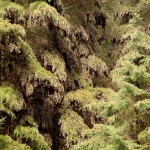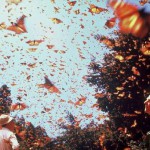
- 15
- 12
- 2010
- Category:
- Exploration & Discovery
- ,
- Service & Advocacy
Monarch Butterfly Sanctuary
The following proposal to make a film about Mexico’s monarch butterfly sanctuary summaries my impressions of an unforgettable trip to that stunningly interesting UNESCO world heritage site.
The annual migration of monarchs is one of the great spectacles of nature on Earth. Our sanctuary trip was followed by a visit and lunch with nearby Mexican culinary legend, Diana Kennedy.
The trip heightened my awareness of the fragility of natural systems such as this great butterfly migration, and for the need to improve habitat protection. Broader awareness of threats to monarchs has led to a variety of stewardship policies. At a very local and personal level we have joined many others in planting milkweed needed to sustain monarch populations.
September 15, 2010
Re: Monarch Butterfly Film
As promised, I’m sending a summary of trip notes and film development thoughts from my visit to the monarch over-wintering sites in the oyamel fir forests of several high (7000-10,000 ft) mountaintops near small villages 100 kilometers NW of Mexico City.
The sanctuary is a stunning sight. Tens or hundreds of millions of monarchs are clustered to tree trunks like some kind of strange feathery growth. Branches bend from the weight of these butterflies which look dullish brown with the undersides of their wings stacked in dense energy-efficient formations against the cool weather. Periodically, as the sun breaks through the clouds, the scene is transformed by stunning explosions of orange and black “flutterfests.” Stimulated by the heat of direct sunlight, millions of monarchs go for a quick ride in airspace that seems barely able to hold them. Minutes later it’s quiet again as the monarchs return to the same trees inhabited by their ancestors after giving us one of the greatest shows on earth. On the day we visited there were only a handful of people present to witness this amazing site.

Photo courtesy UNESCO
Below is my understanding of the story of discovering these over monarch wintering/reproductive colonies, along with a little about the amazing biology of the monarch migration. I first heard the story from Rudolfo Ogarrio while climbing in Bhutan. Rudolfo guided our visit to the monarch sanctuary and is a well known environmental leader in Mexico.
Finding and Protecting the over wintering Location
A Canadian researcher named Fred Urquhart studied monarch biology including migration patterns for more than 30 years, including by attaching tape with his telephone number to their wings. The breakthrough came when he enlisted someone in Mexico City to take calls there and was able to triangulate locations into the Mexican state of Michoacan and finally to the tops of high mountains there where, of course, locals had always experienced vast annual butterfly (mariposa) visits. They weren’t aware of its uniqueness.
In 1976, Urquhart guardedly published the existence of these monarch sanctuaries and the migrations that emanated from them. However, in the National Geographic article that broke the story, he would not reveal the location and attempted to make it difficult to find. Nor would he tell fellow researchers, all for fear of destroying the sanctuary that he had obsessively spent his live discovering.

Photo courtesy National Geographic
Rudolfo Ogarrio tells a wonderful story about his role in discovering and protecting the monarch breeding sites. As I recall, his niece was planning to get married when the National Geographic article was published and she and her fiancé vowed not to marry until they found the monarchs. Months later after searching throughout Mexico for clues, they stumbled across someone who had seen Urquhart (“the man in the picture”) in a village that day. They patiently tracked Urquhart down several days later and, after overcoming stiff resistance, were allowed to join him for a site visit. Stunned by what they saw, they brought a monarch to Rudolfo and told their story. This launched a 10 year campaign to have the sanctuaries designated UNESCO World Heritage Sites with all the protection that goes with that.
The battle for protection, of course, is a story unto itself.
Monarch Migration Biology
Monarchs typically leave the 11-12 colonies in the Michoacan sanctuaries in February or March and fly north via well established flyways. It takes 3-4 generations, reproducing via eggs laid primarily on milkweed, to reach the northernmost realm of their habitat in the Northern US and Canada. A final south migrating generation then makes the trip back in a single season, traveling up to 3000 miles to arrive at the same tree that its ancestor departed from—by October. This involves daily travel of 50-100 miles with records of up to 250 miles. The monarchs appear to follow well-established flyways even though they are newborns traveling without adults. Much has been studied about the biology of this navigation system. Monarchs are believed to be the only insects that share this kind of two-way migration with birds.

Of course there are fascinating issues associated with monarch development stages, ecology, habitats, predation, etc. The destruction of local and migratory habitats represent significant threats to the sustainability of monarch populations.
The monarch story would make a fascinating film with compelling story lines, interesting characters, amazing science and stunning visuals. I’ve spoken with several people about this prospect and look forward to getting your perspective.
Please click here to watch a short film about the amazing migration of monarch butterflies.
Recent article about Monarchs in Science: One hundred and one monarch genomes reveal surprising history of this long-distant migrant





































